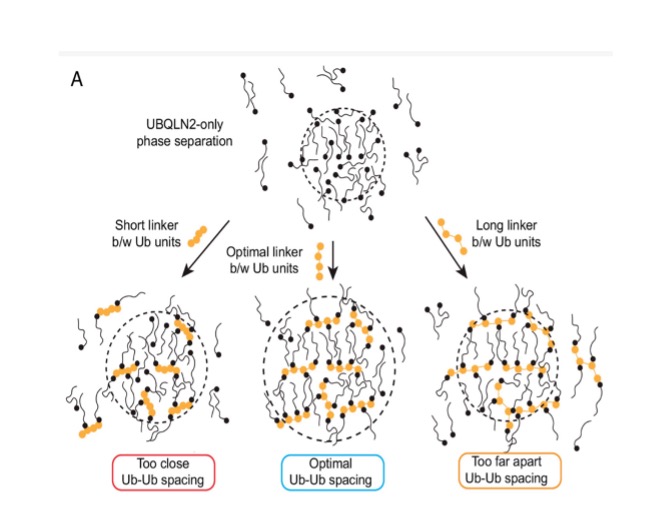
Biomolecular condensates are involved in a range of cellular processes including stress response, protein degradation and gene expression. These condensates contain a wide range of unique macromolecules, but the drivers of this condensation, referred to as scaffolds, comprise only a very small fraction. The non-driver components are commonly referred to as ligands and may not phase separate on their own but nonetheless may help regulate assembly, disassembly and other material properties. One such ligand is ubiquitin (Ub) or its linked multimers (polyubiquitin chains), which are attached as posttranslational modifications to partner proteins and help determine various downstream signaling outcomes such as DNA repair. There is growing evidence that suggests the involvement of polyUb chains in phase separation acts as a mechanism for the reading and interpretation of said Ub code in the cell. Research from the Castaneda lab at Syracuse University has worked towards understanding the molecular rules by which polyUb chains are able to regulate biomolecular condensation.
To systematically investigate the relationship between polyUb features and phase separation, the authors developed a library where they modified either the linker length and/or flexibility between the Ub units or the binding affinity between Ub and the phase-separating binding partner, UBQLN2. A combination of temperature-ramp turbidity assays, size-exclusion chromatography-coupled SAXS (SEC-SAXS), multi-angle light scattering (MALS) and NMR to characterize a range of different was used characterize how differing physical properties modulate phase separation. SEC-MALS-SAXS experiments performed at BioCAT were used to characterize the overall conformations of the polyUb hubs with linkers of varying lengths and flexibilities. The authors found that two main properties of multivalent polyUb chains primarily contribute to the regulation of phase separation. In particular, they find that the spacing between the binding sites (as a consequence of effective linker length) and the Ub-UBQLN2 binding affinity are the primary driving forces that enable tunability of the phase separation. The overall effect on condensates is more akin to an emergent property as opposed to the sum of individual parts. This work provides a set of basic rules by which polyUb properties can regulate phase separation, and it is likely these frameworks can be expanded to other posttranslational modifications in phase-separating systems.
See: Sarasi K. K. Galagedera, Thuy P. Dao, Suzanne E. Enos, Antara Chaudhuri, Jeremy D. Schmit, and Carlos A. Castañeda. Polyubiquitin ligand-induced phase transitions are optimized by spacing between ubiquitin units. Proc Natl Acad Sci U S A 120: e2306638120 2023. DOI: 10.1073/pnas.2306638120. PMCID: PMC10589717